Page 1 of 2
* 720 Front Suspension *
Posted: Wed Aug 16, 2006 9:25 am
by philip
Here's a photo of the 2WD front suspension. This one is "healthy" ... now.

BUT, such was not always the case.
Suspension tale
Additionally, many '81 and '82 720 trucks did not have a sway bar. I discovered this walking through numerous junk yards. So my '82 shown here got the upgrade. Money WELL spent!!
Posted: Wed Aug 16, 2006 12:10 pm
by redmondjp
Thanks for the excellent information and photos, Phillip!

I've got to check my truck to see if I have the sway bar--my guess is no, based upon the way that it corners (terribly).
On a somewhat related note, from looking at your picture I see that you have the non-ventilated front brake rotors as I do. I have noticed on my trips through the boneyards that the later-vintage (say, '84-86) 2wd nissan pickups seemed to come with ventilated front rotors, and I've thought about trying to swap over (parts are cheap at Pull-a-Part), given some unknown source of free time in my future.
Has anybody tried this swap yet, and if so, is it worth it? I imagine it would only make a difference in time-to-fade if one were hauling heavy loads or doing a sustained amount of downhill driving (although with the throttle plate, the vehicle has a good amount of engine braking).
Posted: Wed Aug 16, 2006 12:47 pm
by philip
redmondjp wrote:Thanks for the excellent information and photos, Phillip!

It's what I do here!

redmondjp wrote:I've got to check my truck to see if I have the sway bar--my guess is no, based upon the way that it corners (terribly).
On a somewhat related note, from looking at your picture I see that you have the non-ventilated front brake rotors as I do. I have noticed on my trips through the boneyards that the later-vintage (say, '84-86) 2wd nissan pickups seemed to come with ventilated front rotors, and I've thought about trying to swap over (parts are cheap at Pull-a-Part), given some unknown source of free time in my future.
Starting in '83-1/2, the calipers and their anchor plates were changed completely. Now they are single piston, floating, and carry brake pads that have probably 60% longer swept area! I cannot say with certainty the steering spindle remained the same.
redmondjp wrote: Has anybody tried this swap yet, and if so, is it worth it? I imagine it would only make a difference in time-to-fade if one were hauling heavy loads or doing a sustained amount of downhill driving (although with the throttle plate, the vehicle has a good amount of engine braking).
And if nothing else, pad life should improve. I've been going through pads every 20-22k miles.
Another consideration though ... would be the brake proportioning valve calibration. It may well be different.
Posted: Thu Aug 17, 2006 12:06 pm
by Zoltan
Another consideration though ... would be the brake proportioning valve calibration. It may well be different.
I have a related question: I noticed that my truck tends to block the rear wheels if I am not carefull with my braking. I might just be an unexperienced truck driver though ....

Is this how it supposed to work or I should look into calibrating the brake proportioning valve?
The other car I am driving is a diesel ford escort wagon with a weight of 2420lb (vs the datsun 2690lb) and I am expecting the truck to be able to slow down more or less the same ... that's how I drive.
Posted: Thu Aug 17, 2006 1:27 pm
by philip
Zoltan wrote:I have a related question: I noticed that my truck tends to block the rear wheels if I am not carefull with my braking. I might just be an unexperienced truck driver though ....

Is this how it supposed to work or I should look into calibrating the brake proportioning valve?
The other car I am driving is a diesel ford escort wagon with a weight of 2420lb (vs the datsun 2690lb) and I am expecting the truck to be able to slow down more or less the same ... that's how I drive.
1). OEM proportioning valves are not adjustable by the owner. In these trucks, Nissan installed a combination proportioning / load sensing device called an "NLSV" (Nissan Load Sensing Valve). The rear part of the combination valve has a chamber with a steel shuttle ball that modifies rear brake application depending on chassis angle and deceleration rate. The forward end contains the proportioning valve.
2). Pickups are nose heavy vehicles with a lot of unsprung weight at the rear due to leaf springs and a heavy final drive. This means the rear axle is more apt to lose traction in spite of the NLSV. 200-300 lbs in the bed improves things. If you're running empty most of the time, 30 psi in the rear tires is plenty.
3). If you do a partial brake job (front pad replacement without turning the rotors), the front brakes nearly always seem to have less braking power than if you had turned the rotors. This means you apply more pedal pressure which puts more stress on the rear brakes ... so they lock up sooner.
4). Prior to the 1983 model year, the rear brakes are not - not self adjusting. You gotta get under there with a brake spoon and do this chore manually.
Posted: Sat Oct 27, 2007 2:29 pm
by Zoltan
I just installed a sway bar from an 84 truck... what a difference it makes on a windy road!!! In the process I stripped the caster nut on the center link ball joint... I think it's an M12, but parts stores don't carry metric caster nuts around here. Can anyone confirm the size of of this slotted nut?
cheers
Posted: Sat Oct 27, 2007 2:49 pm
by asavage
That's a castle nut, not caster.

I have a new center link in a box . . .

I'll try to measure it tonight. It's seven miles away.
Posted: Sun Oct 28, 2007 12:41 pm
by asavage
I screwed a 12mm x 1.50 bolt into the castle nut from my center link's end. This is a finer thread than "normal" for 12mm.
Surprisingly, my local hardware store actually carries 12mm x 1.50 castle nuts, though in class 8.8 (fairly soft). $4.25 ea. Supplier is Midwest Fastener, a common hardware supplier for hardware stores in my area.
[later]
Apparently, class 8.8 is actually the strongest class in which castle nuts are available.
I also just learned something else new (it only hurt a little): there's a difference between slotted nuts and castle nuts. Go figure.
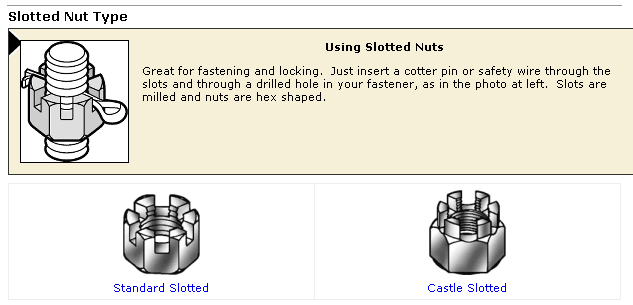
Amazon sells a
12mmx1.50 nylock nut for $2.28. Many ball joints use nylock nuts rather than a castle or slotted nut.
Metric Specialties lists a
12mmx1.50 slotted nut (Part No. 12FNCL) for $1.90 ea.
I spent a surprising amount of Google time locating just those. I'm certain that this nut is used elsewhere (Honda & VW come up in references).
Posted: Sun Oct 28, 2007 8:38 pm
by Zoltan
asavage wrote:I spent a surprising amount of Google time locating just those. I'm certain that this nut is used elsewhere (Honda & VW come up in references).
Thanks for going the extra mile

!!
I didn't know that a nylon lock nut can be used instead of the castle/slotted nut ... The nylon lock nut I CAN get from my favorite hardware store... Hurray !!! So it's a M12/1.50, thanks a lot.
All I can say folks, if you're not driving a Honda or Toyota, think twice before moving to Hawaii ... choices and supplies are very limited.
Posted: Sun Oct 28, 2007 9:19 pm
by asavage
A nylock nut can be used if you can get full thread engagement into the nylon. You could use a plain hex nut and a split lockwasher, for that matter. Or a plain hex nut and a cotter pin, or safety wire. Lots of ways to skin this particular cat.
The main disadvantage to nylock is that you can only use them once.
Posted: Sun Oct 28, 2007 10:25 pm
by philip
Zoltan wrote: I didn't know that a nylon lock nut can be used instead of the castle/slotted nut ...
They cannot. At GM,Ford,Chry, and most all other vehicle manufacturers long ago ... learned (lawyers and $$$) about steering and suspension parts reliability. Cotter keys and metal self-locking nuts are -still- the best.
Posted: Sun Oct 28, 2007 10:46 pm
by asavage
1985 Colt Vista lower ball joint:

1985 Subaru 1600 lower ball joint (BA 1013490):


1985 Chevy Sprint lower control arm w/ball joint (BA 101-4343):

I could go on.
Posted: Mon Oct 29, 2007 6:05 am
by philip
"Zoltan" is talking about "steering" link. Not his A-arm (suspension).
When ball joints and/or tie-ends are "sealed" in (no zerks), then nylon locks can be used. But when ball joints or tie-ends have grease zerks then ... castle nut with cotter pins only.
This 85 Subaru 1600 has OEM "sealed" ball joints, yet this manufactured has chosen cotter pins.
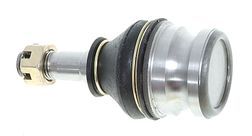
This 85 Colt Vista tie-end with grease zerk has castle nuts.
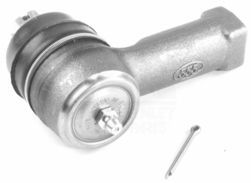
But the same 85 Colta Vista option part when "sealed" ... has nylon lock nuts.
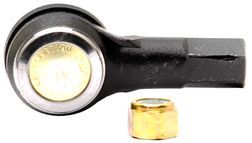
This 85 Chevy Sprint does not use nylon-lock nuts. This nut has a flange head that distorts when torqued.

Here is my recently sold 2003 Corolla. OEM parts.
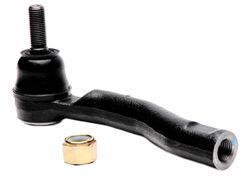

Here's the '03 Corolla's lower ball joint. It is "sealed" but ... it's close to the road filth so ... castle nut.
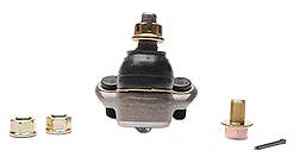
The important here .. to "Zoltan" is ... THESE old truck steering components have zerk fittings and need to use castle nuts and with cotter pins. Everyone has noticed how sloppy grease has soaked those castle nuts ... and more!


Posted: Mon Oct 29, 2007 10:13 am
by asavage
The presence (or not) of a lubrication zerk has no bearing on the suitability of any particular fastener. Caked with grease or dry as Death Valley, doesn't matter.
Posted: Mon Oct 29, 2007 5:22 pm
by plenzen















